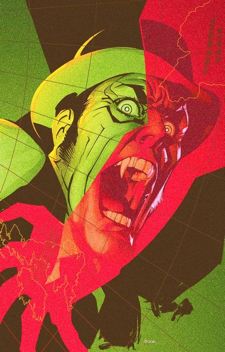Welcome to Wednesday Comics Pull-List, here on Tor.com! Every week we post reviews of a select handful of this week’s comic releases. From those reviews, we let you know what we would pull for keeps.
This week’s batch includes:
- Batman: The Return of Bruce Wayne #6 (of 6)
- Dungeons & Dragons #1
- Halcyon #1
- Insane Jane: Avenging Star #2 and #3
- The Thanos Imperative #6 (of 6)
- Victorian Undead Special: Holmes vs. Dracula #1 (of 5)
This was an odd, odd week and the exceptional releases were few and far between, hence the shortened list of reviews. Was it just us, or did it seem like the comics industry was taking a break this week?
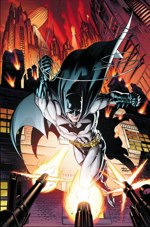 Batman: The Return of Bruce Wayne #6 (of 6)
Batman: The Return of Bruce Wayne #6 (of 6)
Written by Grant Morrison
Art by Lee Garbett & Pere Perez
(DC Comics)
Pull: No. Wait, no? WTF?
Chris says: Well, that was… Hm. Okay.
I’ve been enjoying the Return of Bruce Wayne mini-series a lot, but I wish it had ended one issue earlier. The concluding issue here is messy, wrapping up lots of plot strands that are absolutely soaking in Grant Morrison’s patented slipstream tropes, and leaving little room for reconstituting the character in time for the issue to end. I enjoy Morrison’s writing and the concepts he works in quite a bit, but in some cases they can be his greatest weakness. When most of your story is concept (even concept literally embodied) you run the risk of eliminating the stakes of your story. Batman’s struggles look like nothing against the static of an entire universe, which is how this issue frames its perspective.
This doesn’t get turned around until very late in the story, so you miss that feeling of triumph that comes whenever Batman beats the odds. The current expansion of the Batman line of books doesn’t help in this regard, since it marginalizes Bruce’s presence in his own legacy.
Ultimately, this didn’t feel like a Batman comic. The other issues in this mini played with genre and story in a way that still felt true to the character. Here, that strength falters.
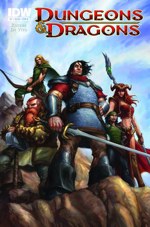 Dungeons & Dragons #1
Dungeons & Dragons #1
Written by John Rogers
Art by Andrea De Vito
(IDW)
Pull: No. The book is dull, tired, and—ironically, given its roots in a game of imagination and storytelling—unimaginative. If you’re looking for a good Dungeons & Dragons adventure, you’d be better off pulling out your old R.A. Salvatore or Weiss and Hickman novels. Or, heck, even the old cartoon series from the early 80s…
Matt says: Sword-and-sorcery fantasy has an unfortunate tendency to blandly rehash old tropes and clichés. In fairness, the Dungeons & Dragons game (and its various multi-media offshoots, spin-offs, etc.) has been a major source of many of these tropes over the last 35+ years. But while there are certain genre-standards that we simply expect (even demand!)—the catacombs, complete with traps; the curses and prophecies; the dragons and other classic monsters—one cannot escape the feeling that reliance on a host of other tropes is due more to lazy or mediocre writing. Take Dungeons & Dragons #1, out this week from IDW. There are some genuinely fresh bits, here—the use of a tiefling (a relatively new player-race) in the hero party, for example—and some genre classics (the pit trap). But they’re mixed in with much larger portions of genre cliché. For example, we have a blonde, elven archer, dressed all in green, hair pulled back. He spends most of the issue good-naturedly bickering with a red-headed dwarf (who, at least, is not wielding an axe). All that separates them from Legolas and Gimli is the quality of the banter, which is far inferior to anything seen in either Tolkien’s novels or their various big- and small-screen adaptations. (And to be clear: I am not saying that Tolkien’s work is full of clichés, for it is the source of the tropes that have since become cliché. Tolkien may have been ripping off classic mythology—but ever since then, everybody else seems to just rip off Tolkien.) The rest of the characters are less obvious, but equally cliché for fans of sword-and-sorcery settings: the halfling thief; the male, human fighter at the head of the party; the mysterious, not-entirely-trusted mage (who, again, is at least made slightly less stale by being made a tiefling); etc.
Worse still, lazy writing is rarely limited to character creation alone. Writer John Rogers falls into a classic trap of the genre, here: he gives us an adventuring party and simply assumes that we’ll mentally fill in their motives based on every bit of fantasy we’ve ever read. Why are these “heroes” banded together into an adventuring party? Why are they adventuring at all? Why are they “heroes” above and beyond this adventuring? We are asked to simply take the love of adventure and an over-simplified moral compass at face value. In fairness, this is often the case when one starts a D&D campaign—you create a character for the purpose of adventuring, and so they “why” very rarely has to be explained. But not needing an explanation and not having one are two different things—whereas a player automatically identifies with and cares about his or her player-character, the reader of fiction makes no such automatic concessions. Instead, it’s a writer’s job to make us care about his or her characters. By not giving them motivation, a writer makes identifying with characters that much harder for the reader.
Given a mediocre script, artist Andrea Di Vito easily keeps pace with Rogers. The storytelling is clear, and the characters are consistent and easy to identify. Beyond this, the art will fail to impress. Nothing about the look of the book is fresh, compelling, or otherwise noteworthy. The anatomy is passable without being impressive, and the linework is clean without being interesting. Di Vito is at least not a lazy artist—he never skimps on backgrounds, and never has to use awkward composition in order to avoid drawing feet, etc. But much of the environmental richness (what little there is) can be credited to colorist “Aburtov and Graphikslava,” probably the strongest contributor to the book.
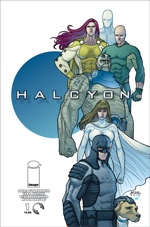 Halcyon #1
Halcyon #1
Written by Marc Guggenheim & Tara Butters
Art by Ryan Bodenheim & Mark Englert
(Image Comics)
Pull: Yes. It’s superheroes-meets-GI Joe-meets-interdimensional-science-villainy, and it’s attractively drawn and colored to boot!
Matt says: Halcyon begins as a mashup between a couple of all-too-familiar ideas. We have a superhero comic centered around yet another JLA-homage. We have multiple dimensions, and various versions of the supervillain teamed up together with himself. And, among the superheroes, we have the classic morality disputes between the super-virtuous hero-types and the grim-and-gritty vigilante-types. But just when the ingredients are perfectly set out for yet another seen-it-a-million-times-before superhero cliché-fest, Halcyon manages to throw in a few twists and serve up a dish that actually tastes fresh.
First, notice that the two strongest members of the JLA-clone (the titular “Halcyon”) are women; indeed, Halcyon’s Superman clone is a woman, Zenith (aka Amanda). Don’t call this a feminist book just yet—Amanda is, of course, sleeping with the Batman clone (Sabre, aka Devlin), and manages to spend 2 of these 22 pages naked—but the idea that earth’s strongest superhero could be a woman is at least a refreshing change of pace. (With relatively little interaction between the various characters in the first issue, we’ll have to wait and see whether or not Halcyon will really be able to pass the Bechdel Test—and meanwhile, three of the nine superheroes introduced in issue 1 are female, so the ratio’s not quite optimistic just yet. But again, making Superman a woman is at least a good start.)
Second, the plot of issue #1 manages to feel novel, and at the very least I was not expecting the cliffhanger turn at the end. Furthermore, despite the fact that most of the basic elements are pulled from genre clichés, at no point in this issue did I feel like I knew exactly where the story was going. Guggenheim and Butters serve up a bit of hackneyed dialogue (mostly falling into the first-issue trap of cramming too much exposition into the dialogue), but the plotting and pacing are solid, and the book never loses your attention. Giving credit where it’s due, artist Ryan Bodenheim (and colorist Mark Englert) keeps the book exciting, too—the storytelling and page layouts are fairly straightforward, but the linework, rendering, and character designs are all sharp and compelling. The color both sets the mood nicely and aids in the storytelling, and special effects are used sparingly and well.
It will take an arc or two before we can really tell whether Halcyon will be an interesting take on some very familiar genres—and whether or not it’ll have anything to offer us beyond novel plot twists. But for the moment, it’s got my attention. Issue #1 is fun, it’s an easy read, and it looks great. For a first issue, that’s good enough for me—I’ll be back for #2, at least.
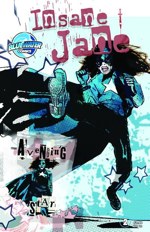 Insane Jane: Avenging Star #2 and #3
Insane Jane: Avenging Star #2 and #3
Written by Zach Hunchar & Darren G. Davis
Art by GMB Chomichuk
(Bluewater)
Pull: Immediately.
Annie says: Having been floored by the first issue I was thrilled when I saw that issues two and three were on the pull list for this week. When we last left Jane and Grant they had just escaped from the asylum and were making a run for it from the hospital security guards. They are destined for adventure and these two issues embody the word.
In issue #2, we find out that not only are hospital security are after the duo but now the local police force is involved. They’re hot on the trail of our superheroes when they get to a waterfall and realize that there’s no possible way that anyone could survive the fall. Except they do. They’re wet and cold and now on the search for a secret lair. They stumble across a house they believe is vacant only to find that Jane’s arch nemesis, Omega One, is lurking in the background. Or is he? As Jane’s medication wears, Omega One is “revealed” as a hermit who had been living in the house that Jane and Grant broke into. After Jane dismantles Omega One’s face with a baseball bat, they decide this location is no longer secure and must move, quickly. They steal a car and decide to head to the train station, all the while, the police are trailing them. After crashing the car into the wall of the train station, our heroes soon realize that the train station is FULL of supervillains (aka pedestrians) and proceed to kill them all.
In issue #3 we find out that our heroes feel as if they need a little break, and head off to Las Vegas to take in some fun. Grant leaves to run some “errands” and tells Jane it might be best for her to relax and take a dip in the hotel pool. No one knows how they got a room or how they’re paying for said room or where Jane got a bikini so quickly but, it’s not really important. The important stuff happens when Omega One shows up again, this time as an ally. The information he gives to Jane is not only heartbreaking but explosive, in more ways than one.
What I continue to love about this comic is that the author does such a killer job of making sure the reader knows that these two characters are absolutely insane. Jane goes off on full-page, virtually incoherent tangents about who knows what and as soon as you flip the page, she’s back to giggling and having a great time, totally innocent to the grim reality she’s creating for herself during these mass killing sprees. You can’t help but love her character because she honestly doesn’t know that what she is doing is wrong. When she uses a rake to smash a pedestrian’s skull apart, she thinks she’s helping make the world a better place. The artwork is consistent in these issues in giving the reader an insight into Jane and Grant’s brains. There is not one bad thing I can say about this comic, ladies and gents. Not one bad thing at all.
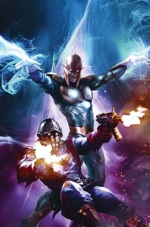 The Thanos Imperative #6 (of 6)
The Thanos Imperative #6 (of 6)
Written by Dan Abnett & Andy Lanning
Art by Miguel Sepulveda & Jay David Ramos
(Marvel Comics)
Pull: Yes, but only if you’re already a fan of cosmic Marvel.
Chris says: The Thanos Imperative mini-series deals with an invasion from another universe where Death herself has been killed. The ruler and lead antagonist from this invading universe is dubbed Lord Mar-Vell. Anyone who has read Alex Ross’s and Jim Krueger’s Earth X/Universe X/Paradise X mini-series might be finding this set-up itchingly familiar. I wonder how Ross and Krueger feel about this mini, especially since the invading universe has been dubbed “The Cancerverse.”
I also wonder how the estate of H.P. Lovecraft feels about the copious amount of Elder God in this comic. And I wonder how we all feel about the inclusion of characters like Cosmo the Russian Space Dog and Rocket Raccoon.
I guess what I’m trying to say is geez, this is an odd one.
Despite the see-what-sticks manner of character and story in the concluding issue of this mini, it nonetheless reads very easily for anyone just looking for a great big Marvel cosmic beat-em-up. A lot of that credit should go to artists Miguel Sepulveda and Jay David Ramos, who convey a lot of power in every page and don’t clutter panels. The characters and macguffins flying around in this book are very inside baseball, however, so I wouldn’t recommend this for anyone not already familiar with the storylines involved.
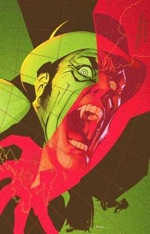 Victorian Undead Special: Holmes vs. Dracula #1 (of 5)
Victorian Undead Special: Holmes vs. Dracula #1 (of 5)
Written by Ian Edginton
Art by Davide Fabbri
(DC Comics)
Pull: NO.
Annie says: The last time I read Victorian Undead, I was frustrated and explicitly explained to you, my dear readers, that this comic wasn’t worth your time. But that was Sherlock Holmes against Dr. Jekyll & Mr. Hyde, this week it’s Sherlock Holmes against Dracula so I figured that was enough of a game changer to try again. For those of you who follow these Wednesday posts, you know how deeply infatuated I am with all things vampiric because it’s seldom talked about. So I was pretty thrilled to thumb through this comic and find that it was totally original in both premise and plot. Can you sense the sarcasm?
This issue was, in short, another waste of my morning. Dracula kills a bunch of people on an old timey ship, doesn’t take any of the expensive cargo that the ship is carrying but has taken a special interest in finding out where the cargo is going. I’d tell you where it’s going, as it was made painfully obvious throughout this issue, but then you wouldn’t have the joy of finding out on your own. Sherlock Holmes and Watson basically traipse around London trying to figure out this “mysterious” crime, allude to something that happened at some unspecified date in Baskerville Hall involving a hound, which is quickly dismissed by the ever sound-minded Watson. “Whitby is a long way from Baskerville Hall, sir.” Well, no, not really. Baskerville Hall is in Worcestershire and it’s about four hours away from Whitby which isn’t all that unreasonable. But who’s nit picking? Then some gypsies show up and shoot Sherlock, but I’m not really sure why and the issue ends with a shot of Buckingham Palace. A man named Lord Godalming has traveled a long way with a very special guest to meet the Queen and solve the royal family’s “unfortunate condition.” That guest’s name is, wait for it, Vlad Dracul. And he is from? Transylvania. Not sure what role he’ll be playing but the good news is that this issue is a two part deal! We get to see what wild and crazy hijinx Dracul is going to put the royal family through.
The illustrations could have been the saving grace in this issue but I can’t say I’m totally into Davide Fabbri’s style. To me, it’s a weird blend between something resembling Pokémon artwork and Warner Brother’s cartoons. Overall, just don’t bother.
Annie Gala wants to be sorry but will never admit it.
When Matt Lampert isn’t writing about comics, he’s a philosophy professor in New York City.
Chris Greenland was going to leave a breadcrumb trail through time for his past self to follow, but knew he’d be too lazy to follow it.










